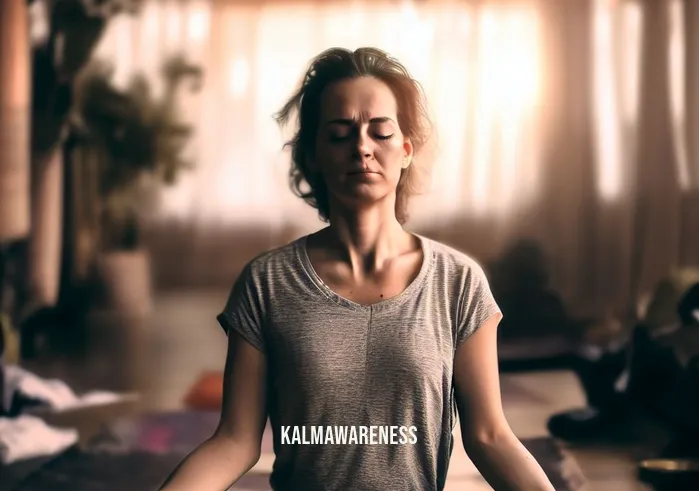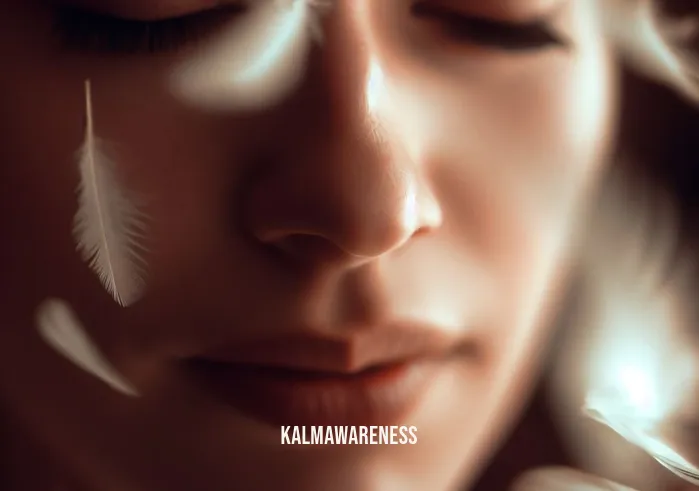The Art and Science of Feather Breathing: A Journey Toward Lightness and Focus
What Is Feather Breathing?
Feather breathing is a specialized form of breathwork that fuses elements of mindfulness, relaxation, and Pranayama techniques to create a holistic method for achieving lightness and focus. Originating from the concept that the act of breathing should be as light and effortless as a feather floating in the wind, this practice aims to bring about mental clarity, emotional balance, and physiological well-being.
The Connection to Mindfulness and Breathwork
Mindfulness is the practice of being fully present, aware of where you are, and what you’re doing. It’s more than merely being aware; it involves shifting from a state of distraction to one of attentiveness. Combining mindfulness with breathwork can be profoundly beneficial, enabling you to cultivate a peaceful state of mind where thoughts are not occupied by worry. This principle is deeply rooted in the concept of feather breathing.
“Breathing is the greatest pleasure in life.” – Giovanni Papini
Why Feather Breathing is Unique
Lightness: One of the most distinctive aspects of feather breathing is its emphasis on ‘lightness.’ This unique trait is crucial in helping you achieve a mental state comparable to floating meditation, which aims for a sensation of weightlessness and detachment from physical stressors.
Focus: Feather breathing is designed to hone your focus, helping you to stay fully engaged with your current task. It helps improve your cognitive functions, similar to the goals of focused minds.
Pranayama Influence: This practice integrates elements of Pranayama, the ancient art of breath control, which offers specific breathing techniques that help in attaining a heightened sense of awareness and relaxation.
Applications in Daily Life
The practical applications of feather breathing extend beyond the meditation cushion. It is a valuable technique to use in various aspects of daily life, from stress management to improving your sleep quality through practices like mindful movement sleep. Feather breathing also serves as an efficient tool to relax and be aware in situations that usually cause anxiety or tension.
For instance, those who suffer from ADHD might find feather breathing particularly beneficial. It is often challenging to maintain focus and manage impulsivity for ADHD patients. Practicing feather breathing can serve as a complementary approach to mindfulness prescriptions for adult ADHD, allowing for better focus and less hyperactivity.
Preparing for Feather Breathing
Before you jump into feather breathing, it’s essential to set the stage:
- Environment: Choose a calm, quiet space where you won’t be disturbed.
- Posture: While it’s possible to meditate lying down, sitting up is generally better for feather breathing as it keeps the spine aligned.
- Intent: Clearly define what you hope to achieve, be it relaxation, focus, or both.
As you practice feather breathing, you will find that the saying “if practice makes perfect, I’m practice’s baby” rings true. Over time, the quality of your breath will improve, bringing enhanced lightness and focus to your everyday life.
This introductory chapter only scratches the surface of the transformative power of feather breathing. Are you curious to learn how feather breathing is performed, how it can be incorporated with other methods like EMDR meditation and hand yoga poses, and how it compares to other techniques like multitasking? Continue reading to delve deeper into this fascinating subject.

Feather Breathing: The Synergy of Technique and Intention
Understanding the Essence of Technique
In any form of meditative practice, the technique is often as important as the intention behind it. Feather breathing is a beautifully balanced blend of both. This chapter will delve into the techniques that form the core of feather breathing, helping you understand the nuances that make this practice so enriching.
Components of Feather Breathing: A Table Overview
| Component | Importance | How to Incorporate in Feather Breathing |
|---|---|---|
| Diaphragmatic Breathing | Enhances oxygen intake | Deep inhale through the nose, expanding the diaphragm, not the chest. |
| Exhalation | Eliminates toxins and fosters relaxation | Slow exhale through the mouth, letting go of all tension. |
| Pause | Moment of stillness and reflection | After exhaling, pause for a few seconds before your next inhale. |
| Mental Imagery | Enhances focus and relaxation | Visualize a feather floating down while inhaling and rising while exhaling. |
| Mantras | Adds an element of mindfulness | Silently repeat a calming word or phrase during the pauses. |
How Feather Breathing Complements Other Practices
Feather breathing can be effortlessly combined with other meditative techniques. For example, the subtle lightness achieved through this method is beneficial when practicing EMDR meditation, a technique used for treating emotional trauma. Moreover, feather breathing aligns well with physical exercises like hand yoga poses, amplifying the relaxation and focus obtained through these practices.
The Importance of Feather Breathing in Modern Life
Stress Alleviation: The fast-paced society we live in is fraught with stress. Feather breathing serves as a mini-vacation for your mind, allowing you to relax and be aware.
Improving Attention: Our lives are filled with distractions. The technique aids in honing your focus, an asset explored in practices like A Brief Meditation on Breath.
Emotional Balance: Achieving emotional stability is often easier said than done. Feather breathing allows you to control your emotions rather than letting them control you. It can be used as a coping strategy, much like the HUG method of shifting your emotional state.
Enhanced Physical Health: Proper breathwork has various health benefits, including improved digestion and a strengthened immune system. Feather breathing teaches you to breathe more efficiently, similar to practices found in mindful movement sleep.
Feather Breathing vs. Multitasking: A Focus Battle
In today’s world, multitasking is often seen as a valuable skill. However, numerous studies have shown that multitasking can be less effective than mindfulness. Feather breathing encourages you to invest your attention in the present moment fully, allowing for increased productivity and improved mental well-being.
Setting the Stage for Advanced Techniques
By now, you may have a clear understanding of what feather breathing involves and why it’s crucial in the modern world. However, we’ve only begun to scratch the surface. Feather breathing can be more than just a stand-alone practice; it can be a powerful catalyst when combined with other techniques, making it a versatile addition to your wellness toolkit.
Are you curious about the advanced techniques that can augment your feather breathing experience? What about combining it with different modalities to amplify its effects, such as can you meditate while high or how to integrate the mindfulness prescription for adult ADHD? Continue reading to unlock the full potential of this transformative practice.

Feather Breathing: The Wellspring of Hope and Inspiration
Breathing In Hope, Breathing Out Fear
Life’s complexities can sometimes make it challenging to find pockets of peace and inspiration. The feather breathing technique, or avian respiration as it is synonymously known, can serve as a small yet profound wellspring of hope. As the writer Emily Dickinson eloquently said:
“Hope is the thing with feathers that perches in the soul.”
The Transformative Power of Feather Breathing
Drawing upon various practices, feather breathing can instill a sense of grounded optimism, especially when it’s part of a broader mindfulness program like Floating Meditation. The practice encourages you to be present, freeing your thoughts from the shackles of worry and allowing your mind to attain a peaceful state. Through feather breathing, you cultivate a sanctuary within, to which you can retreat whenever the chaos outside becomes overwhelming.
As the mindfulness expert Thich Nhat Hanh once said:
“Feelings come and go like clouds in a windy sky. Conscious breathing is my anchor.”
Empowering Children and Families
Feather breathing is not an isolated adult-only practice. It can provide a foundation for calming activities for children as well. Invoking the technique’s imagery of a feather floating gently down can inspire wonder and imagination in young minds. Feather breathing serves as an excellent tool for families, making it a bonding activity that bridges generations.
Another enlightening quote that aligns with the spirit of feather breathing is from Viktor E. Frankl:
“When we are no longer able to change a situation, we are challenged to change ourselves.”
Feather Breathing and Personal Growth
Personal development often requires a balanced mind and a hopeful outlook. Incorporating feather breathing into your daily routine can amplify your focus and enable you to engage more productively in activities that require your utmost attention, such as when you are attempting to keep your mind unoccupied with definitions or worries. This technique nurtures a mindset conducive to growth and a willingness to take the next steps in your journey.
Rumi, the 13th-century Persian poet, shared a perspective that complements the art of feather breathing:
“The quieter you become, the more you can hear.”
A Preview of What’s Next
By now, you have a comprehensive understanding of feather breathing as a technique, its complementary practices, and its transformative role in instilling hope and inspiration. Yet, as with any practice, consistency is key. It’s one thing to understand the concept and another to weave it into the fabric of your daily life. So, how can one build a sustainable feather breathing practice? And how can this practice assist those with more specialized needs, such as adults dealing with ADHD or individuals seeking a focused mind?
To uncover these insights and to delve deeper into the nitty-gritty of building a routine that incorporates feather breathing, we invite you to continue reading. Your journey into a more hopeful, focused, and tranquil life is just a breath away.

Feather Breathing: The Nitty-Gritty Unveiled
A Comprehensive Lens on Avian Respiration
In the quest for relaxation and mental well-being, feather breathing has shown itself to be a powerful technique. However, to reap the full benefits of this practice—or as it’s often referred to, avian respiration—one must delve deeper into its components and nuances. By exploring the subtleties, we’ll not only unlock the transformative potential of this practice but also create a practical pathway for integrating it into our daily lives, just like Mindful Movement Sleep or Hand Yoga Poses can be integrated.
The Anatomy of Feather Breathing
This chapter is dedicated to dissecting feather breathing, breaking it down into bite-sized portions for better understanding. We’ll explore:
- Mechanism: How the breath travels and impacts our body and mind.
- Practicality: The best times and settings for practice.
- Associated Activities: Linking feather breathing with other practices such as a brief meditation on breath or EMDR Meditation.
Mechanism: The Flow and Impact of Breath
- Inhale Phase: The initial stage where the air enters through the nostrils, simulating the light ascent of a feather.
- Duration: Typically, a 4- to 6-second inhalation.
- Effect: Oxygenates the body, calms the mind.
- Hold Phase: A brief pause before the exhale.
- Duration: About 2 seconds.
- Effect: Facilitates a moment of reflection and relaxation awareness.
- Exhale Phase: Controlled release of air through the mouth.
- Duration: Around 6-8 seconds.
- Effect: Relieves stress and mental clutter.
Practicality: The When and Where
- Morning Practices: Kickstart your day with a session, perhaps when you’re practicing Hug Method Shifting.
- Midday Breaks: A quick 5-minute session can re-energize your focus.
- Evening Wind-down: Before bed to improve sleep quality.
Associated Activities
- Mindfulness Activities: Pairing feather breathing with focused practices.
- Yoga: Incorporate it within your yoga sequence to deepen your poses.
- Meditation: Enhance your flight rising meditation by adding feather breathing into your routine.
Beyond the Basics
After you have familiarized yourself with these components, you can begin to incorporate more advanced aspects into your practice, such as:
- Body Awareness: Combining the breath with a conscious touch of body parts, similar to the Touch That Body Part technique.
- Mental Shift: Moving from a multi-tasking mindset to a more mindful approach.
What Lies Ahead
Now that we have an in-depth understanding of feather breathing and its many facets, what’s next? How can we sustain this practice over the long term? In our final chapter, we will explore how to make feather breathing a lifestyle choice rather than a mere practice. We’ll delve into the science of habit formation, personalized strategies, and long-term benefits.
Curious to discover how to embed this transformative practice into your daily life seamlessly? Continue reading for the grand finale—a culmination of everything you’ve learned, wrapped up with actionable steps to make feather breathing an integral part of your life journey.

Feather Breathing: A Breath of Fresh Air in Your Self-Care Routine
The Aerial View of Our Journey
As we conclude this exploration of feather breathing—also known as avian respiration or airy inhalation—it’s time to take a step back and marvel at the landscape we’ve covered. From the basics to the intricate details, we’ve traversed a significant expanse of understanding that goes beyond mere breathing. The art of feather breathing is a pathway to serenity, just like the mindfulness prescription for adult ADHD can be a guidepost for focus and calm.
Feather Breathing: Not Just an Exercise but a Lifestyle
Yes, feather breathing is a form of exercise for your lungs and mind. But as we’ve seen, it extends its gentle touch to virtually every aspect of your life. Whether you’re in the office, practicing U-Relax Moving, or simply spending a quiet moment alone, the airy inhalation technique can be your silent companion, helping you build a peaceful state of mind where thoughts are not occupied by worry.
Reflections and Milestones
In a society that often values speed over quality, feather breathing serves as a gentle reminder to slow down and appreciate the beauty of each moment. As the famous saying goes, “Rome wasn’t built in a day,” and neither is mastery in feather breathing or any other technique like floating meditation. Keep practicing, keep fine-tuning, and most importantly, keep inhaling and exhaling those soft, feathery breaths. Remember, practice makes perfect.
Our Final Words: Feathers Light, Heart Lighter
So, here we are at the end of our enlightening journey. But in many ways, this is just the beginning. The insights and knowledge you’ve gained are the seeds. Now it’s up to you to water them with continuous practice and perhaps even integrate them with other activities like Kid Calm or lying down to meditate.
Your Next Steps and Our Heartfelt Gratitude
Feeling like revisiting some of our earlier discussions? Feel free to flip back for a quick refresher. Want to explore more avenues for personal growth? Our magazine is teeming with articles that help you gain insights into different dimensions of well-being, from understanding the definition of keeping in mind to the plethora of mindfulness practices available.
We can’t thank you enough for investing your time and energy into reading this comprehensive guide on feather breathing. Your presence is our motivation, and we promise to bring you more insightful, transformative content in the coming editions.
So, until then, keep your feathers light and your hearts even lighter! Happy feather breathing! 🌬️





